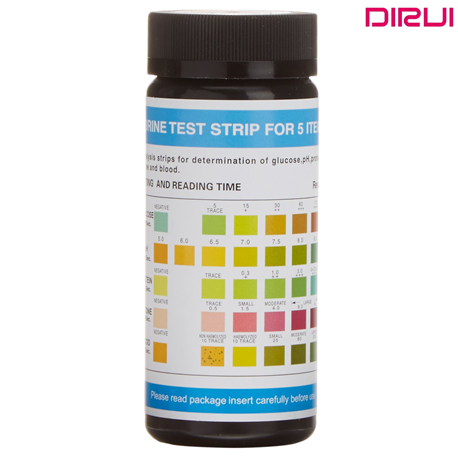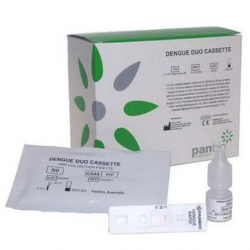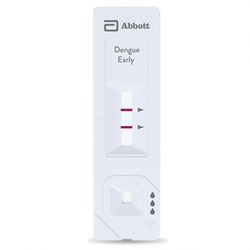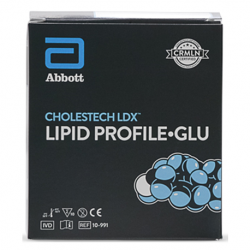DIRUI 5 Parameter Reagent Strips for Urinalysis (100 strips/bottle) by Dirui
Short Description
Professional DIRUI Urine reagent test strips for the rapid determination of Ketones, Glucose, Protein and pH plus Blood
Share This Item
Professional DIRUI Urine reagent test strips for the rapid determination of Ketones, Glucose, Protein and pH plus Blood, These are the diagnostic reagent strips used by physicians, clinics and hospitals to initially screen for suspected and/or existing health conditions.
Simple to use, urine diagnostic reagent strips can provide early indications of developing health problems and identify potential abnormal functions requiring more extensive testing. Additionally, routine use is frequently recommended by physicians for monitoring certain existing and chronic health conditions.
Product Features
-
1 Tube has 100 test strips
-
5 tests on each stick
-
Used within NHS
-
Designed for use by GPs, Clinics, Community Nurses, Healthcare Units and A&E Departments.
-
Each test detects Glucose, pH, Blood, Protein & Nitrite
-
Immediate test results -Professional Accuracy.
These urinalysis test strips test for:
-
Glucose
-
Protein
-
pH
-
Ketones
-
Blood
They are simple, easy to use reagent strips for the detection of key diagnostic chemical markers in human urine. They are the same test strips used routinely by doctors, laboratories and healthcare professionals in preliminary diagnosis of, and initial screening for potential health problems.
Dirui Strips are plastic strips to which chemically specific reagent pads are affixed. The reagent pads react with the sample urine to provide a standardized visible colour reaction within 30 seconds to one minute depending on the specific panel screen.
The colour is then visually compared to the included colour chart to determine the level of each chemical factor. Test results may provide useful information regarding carbohydrate (sugar) metabolism (diabetes), kidney function, acid-base balance, bacteriuria, occult blood , high leukocytes (infection) and other conditions of overall health.
The strips are ready to use upon removal from the vial and the entire reagent strip is disposable. The test strips are packed 100 tests to a vial. Each vial comes with a complete abstract on the chemical and biological properties of the test including a colour chart for rapid visual diagnosis.
How to Test
1. Take strip out of container and immediately close container
2. Immerse the test strip in a well mixed sample of urine. Take the strip out of the urine collection container and let any excess urine fall into urine container. Dry the edge with a disposable hand towel
3. Compare the colours against the results printed on the outer test strip container and at the same time record results.
4. If the Urine is not thoroughly mixed prior to immersing test strips this will result in incorrect results.
5. Leukocytes and Erythrocytes may remain at bottom of container if not mixed correctly and may show incorrect results
Significance of Ketones in diet programs.
Is your body burning fat cells? The presence of elevated levels of Ketones in human urine is a primary indicator that the body is in ketosis. Ketosis simply means that the body's stored fat cells are being utilized as a primary fuel source to produce energy. The by products of fat metabolism are Ketones. Ketones are not stored by the body and are eliminated as detectable waste products in urine. Therefore, monitoring the level of Ketones is presumptive of, and directly correlated to the metabolizing, or burning of stored fat cells to produce energy. Likewise the conclusion can be drawn that the higher the concentration of Ketones in urine, the higher is the amount of fat cells metabolized by the body. Ketone test strips are used routinely to help measure the progress of dieters especially those maintaining a low carbohydrate diet. Additionally, ketones are monitored in individuals with Type 1 diabetes. In diabetics, high ketone levels indicate ketoacidosis, a complication of inadequate insulin levels that can lead to diabetic coma. In overall health considerations, high ketone levels are generally an indication of abnormal nutritional conditions, including starvation, fasting, anorexia, high protein or low carbohydrate diets.
SIGNIFICANCE OF DIAGNOSTIC REAGENT PANELS
Depending on the test and specific reagent panel, abnormal levels of specific chemical compounds contained in urine can be easily and readily identified as potential risks factors to overall health and/or indicators of underlying health problems.
Diagnostics Reagent Strips for Urinalysis are firm plastic strips to which are affixed several separate reagent areas.
The reagent test areas on Diagnostics Reagent Strips are ready to use upon removal from the bottle and the entire reagent strip is disposable. The strips may be read visually, requiring no additional laboratory equipment for testing.
The directions must be followed exactly. Accurate timing is essential to provide optimal results. The reagent strips must be kept in the bottle with the cap tightly closed to maintain reagent reactivity. To obtain optimal results, it is necessary to use fresh, well-mixed, uncentrifuged urine.
Reagents: (Based on dry weight at the time of impregnation)
Glucose: 1.7% w/w/ glucose oxidase (microbial, 123U); 0.2% w/w peroxidase (horseradish 203U); 0.1% w/w potassium iodide
Ketone: 5.7% w/w sodium nitroprusside;
Blood: 26% w/w diisopropylbenzene dihydroperoxide; 1.5% w/w tetramethylbenzidine;
pH: 3.3% w/w methyl red; 55% w/w bromthymol blue;
Protein: 0.1% w/w tetrabromphenol blue;
Indications
For In Vitro Diagnostic Use.
As with all laboratory tests, definitive diagnostic or therapeutic decisions should not be based on any single result or method.
Warnings
-
Store at temperatures between 15°-30°C(59°-86°F) and out of direct sunlight.
-
Replace cap immediately and tightly.
-
Do not remove desiccant form bottle.
-
Read enclosed directions carefully.
-
Do not use after expiration date.
-
Use only if tamper evident seals on this carton are intact.
These are the diagnostic reagent strips used by physicians, clinics and hospitals to initially screen for suspected and/or existing health conditions.
Simple to use, urine diagnostic reagent strips can provide early indications of developing health problems and identify potential abnormal functions requiring more extensive testing.
Additionally, routine use is frequently recommended by physicians for monitoring certain existing and chronic health conditions.
Procedure and Use:
-
Collect a fresh urine sample in a clean, dry container preferably glass. First morning samples contain the highest concentration of target markers.
-
Remove one reagent strip from the bottle and immediately replace the container cap, minimizing the exposure of the remaining test strips to light and air.
-
Completely immerse the reagent pads of the strip in the urine sample and then remove immediately to avoid dissolving out the reagent pads.
-
While removing the reagent strip, run the edge of the strip against the rim of the specimen container to remove excess urine. Hold the strip in a horizontal position to prevent possible cross contamination of chemicals located in adjacent reagent pads.
-
Compare the colour change of reagent pads to the corresponding colour chart on the bottle label. Read results according to the chart's time frame for each panel tested.
-
Record the results of your readings for discussion and/or evaluation with your physician or healthcare provider and then discard the used reagent strip.
Standard warranty covered by the seller against any manufacturing defect. In such events, please report to us within 7 days from the date of delivery at connect@lumiere32.sg.
Overall Customer Rating:
0 customer reviews Sign In Or Register to post your reviews. Sign Up0 customer reviews found.
Customers who viewed this item also viewed
Request Quote
Please fill all the details
Write Review
Please fill all the details
Request For Pre-order
Please fill all the details
Request For Product Catalog
Please fill all the details
Request For Sample
Please fill all the details
Request For Sample/Demo
Please fill all the details
Ask More Information
Please fill all the details
Request for Quote/Pre-book
Please fill all the details




